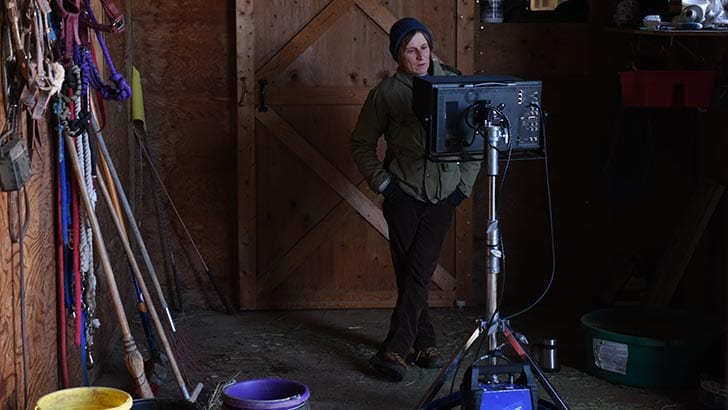
Kelly Reichardt is an American filmmaker whose works include Wendy and Lucy [2008], Meek’s Cutoff [2010], and Night Moves [2013]. Her first film, River of Grass [1994], played at the Brattle Theatre earlier this summer. Her latest film, the Montana-set Certain Women [2016]—which adapts three short stories by Maile Meloy, with roles played by Laura Dern, Michelle Williams, Lily Gladstone, and Kristen Stewart—opens in Boston this Friday. Reichardt was a student at the School of the Museum of Fine Arts (“I think it must have been ’84–’87”), which we were discussing at the start of the phone call transcribed here.
The word “slow” is often deployed in reference to your work. I think I’d prefer to use “still.” One reason I bring up the School of the Museum of Fine Arts is because I wondered if forms like painting and still photography influence the way you compose your own imagery.
Yeah … I’m not sure that still is better than slow, though. It’s really just about hunkering down and being able to spend time in a place long enough that you can get accustomed to routine, and the smaller strokes of a day. I’ve been teaching with Peter Hutton* for a decade—a filmmaker that passed away this summer, who influenced me greatly. He made landscape films; he referred to them as “reels.” And he talked constantly about being in places long enough to really see them. Really see. And I don’t know how you do that in a flash. My shots actually aren’t that long. It’s only in comparison … It’s really just about being in places long enough to be able to see.
In calling the films still, I was thinking about blocking more than shot length. Like the scene in the bedroom at the start of Certain Women, or the way we cut into the cafe. There’s not a lot of forward movement.
The first images I was working off of, more for color and tone, were Milton Avery’s paintings. Then I was looking at so much Alice Neel. Some of the set design, and even the posturing of people, came from her paintings. I’ve used Robert Adams over the years—someone who really focused on the natures of backdrops, and whatever the footprint of the time is. And I had my Stephen Shore books with me. Because his parking lot photos are so beautiful and ugly at the same time. He had much better cars to work with than we do now. But there are a lot of parking lots in the movie, so thinking about how he uses those spaces was helpful.
The direct source for the movie is obviously literary. “Travis B.” and the other stories you adapted often reveal the biographies and inner lives of the characters. I would say your movie exists almost entirely outside of them, though. There’s one insert shot from a man’s point of view, and I was surprised that we even got to see that. What were your methods in deciding what to elide and what to include?
It was a long process. I played around with it for a year. I dropped out some stories. I was trying to figure out if there was a way that they would add up to more as a whole than they would individually. And I made trips to Montana, which ended up being very helpful. I had passed through Montana a lot, but I hadn’t hunkered down there and really looked closely at some of the areas. I went up to Helena, Billings, Butte, Livingston, Bozeman. And the first thing that really dawned on me, and helped me figure out how to see the movie, was seeing how native references echoed through all this prefab hotel art and restaurant art. There’s almost nowhere you can go where there are not native references all around. But you don’t really see any brown faces. It’s so white. So it’s weird how there’s this commodity of native faux art out there in the west. I thought that spoke really loudly. And I made that a thread in the stories.
One thing during the process that always helps is to go spend time in the place you’re making the film about. So that you’re not like a tourist, and you can get down into a routine. What kind of car you’d be driving, where you’d be living, and shopping for your groceries, taking your recycling, or whatever it is, your day-to-day. Or in this case, working on the ranch. It’s really helpful for figuring out the details. And the people you’re meeting along the way while doing all this research—it brings a lot of unexpected answers. A lot of what you find out isn’t the thing you went out looking for, but you still ended up figuring something out. So anyways, it’s just a process, I guess.
You bring up the idea of finding something that links the three stories together. While watching the movie I found myself resisting the urge to try and connect those dots.
That’s good. I just don’t think that they’re plot driven, for the most part. And what runs through them appears differently to [any] different viewer. I hope the overall takeaway is … that your best self is your worst self. And sometimes you have these really close, connected moments with strangers. And then really estranged and faraway moments with the people you’re most intimate with. You can be right next to someone and not really see what their needs are. You can be wrapped up in your own bubble.
There’s the Jared Harris character, who’s in his 50s, and is almost having his feelings hurt by this “surprising” fact that the system isn’t working fairly. And he’s in a car, one foot away from a female lawyer [Dern] who, you know … If you’re a working woman, or a person of color, you know that at a much younger age. Or if you’re from a certain socioeconomic class, you’re going to realize that much sooner. That loss of innocence comes earlier.
Likewise, she’s in her own bubble, and is not really realizing how catastrophic her own blasé attitude towards him is. And what it’s costing him. While physically, they’re so close to each other. Same for the relationship in the second story, where the couple [Williams and James LeGros] comes together, and are closest, when they’re trying to get something from a stranger. And not understanding the costs or the implications of that, or of not connecting with their kid. It’s a lot of misses. Close encounters and misses. That runs throughout the film. Maybe more than commonalities, it’s more like, there’s so many different ways to misunderstand someone.
Transcript has been condensed and edited for clarity.
*The Harvard Film Archive will present “Time and Tide. A Tribute to Peter Hutton” next month, with programs on Thu 11.10, Fri 11.11, and Sun 11.13. See hcl.harvard.edu for showtimes.
CERTAIN WOMEN. RATED R. OPENS FRI 10.21 AT THE KENDALL SQUARE CINEMA.

